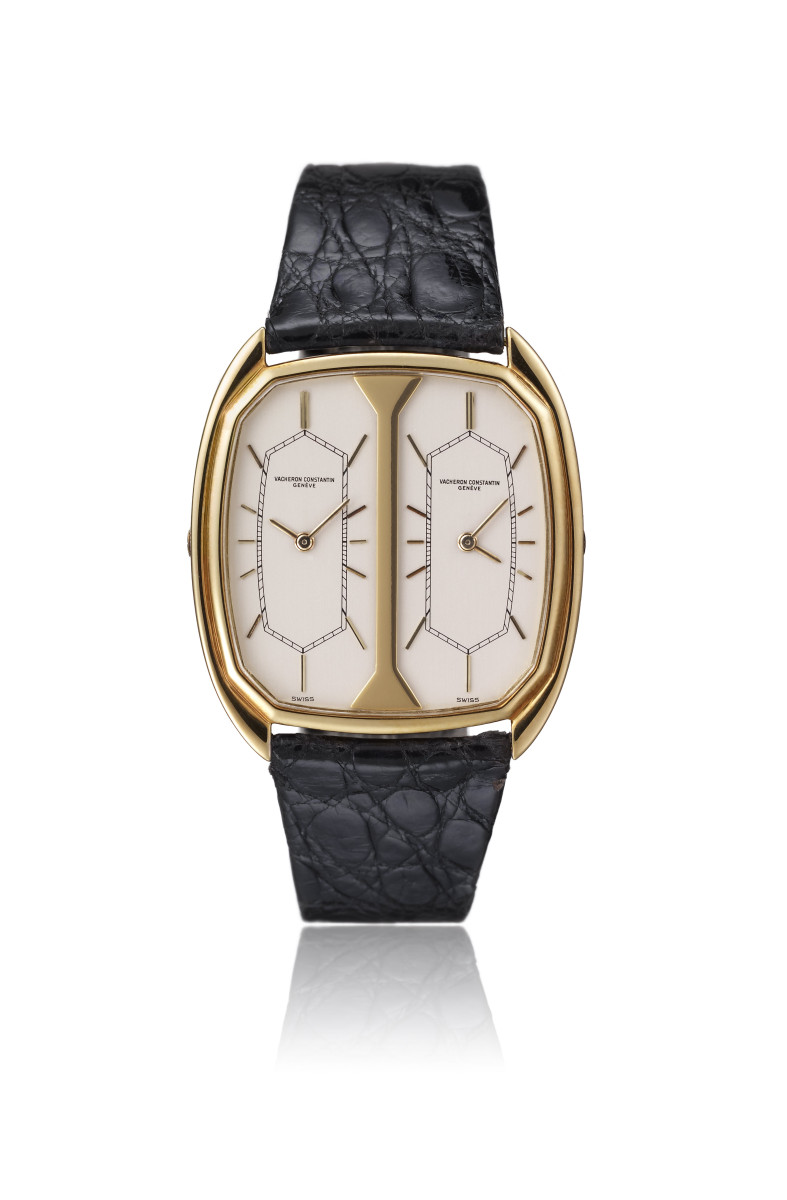Source: Images and content by Vacheron Constantin
http://content.presspage.com/uploads/1999/8e416c13-1ac2-49ff-919b-7e4769ca047f/500_vac-fgta-10337-1982.jpg?10000
Embargo lifted on 9 April 2024, 8.30AM CET
From 9 to 22 April 2024 at Geneva
- A travelling exhibition of historical Vacheron Constantin timepieces celebrating the Maison’s creativity across three centuries of history.
- “From Geometry to Artistry”, a theme that illustrates the symbiosis between design and mechanical ingenuity.
- Watches from the Vacheron Constantin private collection, backed by archives that are unique in the watch industry.
Vacheron Constantin presents “From Geometry to Artistry”, an exhibition illustrating the subtle alchemy that transforms mechanical watchmaking into objets d’art. Selected from among some 1,600 timepieces in the Maison’s heritage, an array of rare and exceptional watches will travel the world throughout 2024.
“From Geometry to Artistry” – the Maison’s annual theme
Transforming mechanical instruments into art and design objects is a cherished Vacheron Constantin reality. A sketch, a geometrical design and its technical extensions give rise to a world of shapes, colours and textures specific to the Maison and its aesthetic values. Far from being self-sufficient, the technical imperatives of a Vacheron Constantin timepiece stimulate aesthetic exploration capable of transcending them. Above and beyond function, “form” expresses the creative momentum uniting artisans, designers, finishers, dial-makers and leather artisans around a single timepiece.The quest for precision, rigorous execution and finely balanced forces – all essential skills in the creation of watch movements – are part of a broader purpose aimed at ensuring a timepiece becomes a medium for conveying emotions. For the Maison, watchmaking “geometry” becomes an artistic field that transforms time measurement into an object of contemplation.
Vacheron Constantin’s rich heritage
All the watches in this exhibition have been selected by the Vacheron Constantin Heritage Department, which is home to more than 1,600 timepieces dating from the 18th century to the present day, as well as tools and items of furniture. This collection is complemented by an impressive archive covering some 420 linear metres. This infinitely rich collection including correspondence between the founding associates sheds fascinating light – both historically and artistically – on the Maison’s activities over the years and centuries. It also lends invaluable documented depth to this “From Geometry to Artistry” exhibition.
A selection of timepieces illustrating 270 years of creativity
Art Deco “staircase” pocket watch in yellow and white gold, two-tone silvery dial – 1931
During the Art Deco period, watches became an essential accessory for the outfits of the time. The style was for these timepieces to feature highly geometric shapes, enhanced by noble materials and a play on colours – as is vividly illustrated by this 1931 manual-winding men’s pocket watch. A favourite for evening wear paired with a dinner jacket, it is distinguished by its square shape with cut angles and its two-tone yellow and white gold case made by Verger Frères – a Parisian jeweller with whom Vacheron Constantin enjoyed a close relationship from the late 19th century onwards. This 39 mm timepiece with its two-tone silvery dial and “staircase” look exudes undeniable graphic elegance.
Ladies’ yellow gold diamond watch, yellow gold bracelet, silver-toned dial – 1919
With the advent of wristwatches in the early 20th century, watchmakers were free to imagine other case shapes representing a break with the traditional roundness of pocket watches. During this period marked by the influence of Art Deco, Vacheron Constantin distinguished itself with its timepieces featuring highly original contours rendered possible by the miniaturisation of watch movements. This lozenge-shaped manual-winding yellow gold ladies’ watch is a perfect example of this new aesthetic quest permeating every detail. Note the hour-markers in the form of radiating Arabic numerals, as well as the Vacheron Constantin signature in the form of a half-ellipse, along with the elegant integration of the yellow gold bracelet featuring extremely slim links.
Dual Time yellow gold watch, frosted silver-toned dial – 1982
Watches have always met the needs of daily life, as demonstrated by the development of minute repeaters in the days before electricity. Multiple time-zone or world time models became popular as soon as intercontinental travel became accessible to all those with a taste for far horizons. Vacheron Constantin did not remain on the sidelines of this development. As early as the 1960s, the Maison began offering timepieces displaying several time zones, such as this 1982 yellow gold quartz model. Housed in a tonneau-shaped case with an octagonal bezel, it mirrors the passage of time here and elsewhere in a rigorously geometrical manner.
Ladies’ yellow gold pocket watch with miniature painting in champlevé enamel – 1854
This 34 mm-diameter 1854 yellow gold pocket watch by Vacheron Constantin features decoration representative of Geneva enamelling, a technique of miniature painting on enamel for which the city became famous in the 19th century. In this example, a mother and daughter are depicted against a pastoral background. The composition is set in a bluish champlevé enamel frame. The exquisitely fine lines of the painting are enhanced by the square border, which is itself integrated within the rounded shape of the watch. This juxtaposition of geometric shapes is the ultimate expression of rigorous artistry stemming from a rare degree of enamelling mastery.
Cioccolatone yellow gold watch, two-tone silvery dial – 1957
An emblematic Vacheron Constantin watch produced between the 1950s and 1960s, this model – appearing here in a yellow gold 32.5 x 35 mm version – owes its Cioccolatone nickname to its shape evoking a square of Swiss chocolate. Inherited from the first Vacheron Constantin thematic auction, this name comes from its distinctive rectangular case with curved longitudinal sides housing a square bezel with softened angles. Equipped with self-winding Calibre 1019, the Manufacture’s first bidirectional-winding movement, this 1957 timepiece is meticulously finished with applied facetted hour-markers on a two-tone silvery dial. The bracelet seamlessly integrated into the watch brancards (vertical sidebars) completes the architectural appearance of this timepiece.
Yellow gold trapeze-shaped watch, sunburst silver-toned dial – 1964
With the advent of battery-operated watches, followed by quartz watches in the early 1960s, not only was the mechanical nature of watchmaking called into question, but also the aesthetic codes of a profession now stirred by fresh creative winds. It was at this time that the first watch designers began to make their mark. While this 1964 yellow gold trapeze-shaped watch remains classic in its use of the famous manual-winding Calibre 1003, the exceptional slimness of its movement nonetheless enabled the disruptive style intended by its asymmetrical trapeze-shaped case. Measuring 27 x 30 mm, it plays on opposites by incorporating a dial with hour-markers arranged in a circle, resulting in a complex composition paradoxically imbued with simplicity.
Elliptical yellow gold enamelled ladies’ watch, enamelled yellow gold bracelet, tiger’s eye dial – 1972
This 1972 jewellery watch is characteristic of an era when women’s watches were breaking away from classical codes and adopting new graphic lines in line with the miniaturisation of quartz movements. While this Vacheron Constantin watch remains faithful to the watchmaking tradition because it is equipped with a mechanical movement, Calibre 1430 nonetheless enabled all kinds of fanciful designs thanks to its extremely small proportions, measuring 12.40 mm in diameter and 2.90 mm thick. This is evidenced by the elliptical shape of the enamelled yellow gold case, flowing into a bracelet composed of the same ellipses held together by large engraved yellow gold links. The tiger’s eye dial completes the composition, making this watch as precious as it is original.
Gem-set yellow gold oval ladies’ pendant watch, Harlequin-style mother-of-pearl dial – 1978
The 1970s were a time of unbridled creativity in many fields, including watchmaking. This yellow gold ladies’ pendant watch made in 1972 is a perfect example. It is powered by Calibre 1003 – which at 1.64 mm thick was the world’s thinnest manual-winding movement at the time of its introduction in 1953 – appearing here in the form of a veritable work of art positioned at the centre of the openworked dial. To highlight it, a Harlequin-style mother-of-pearl mosaic plays on light effects, while the bezel adorned with a snow-set diamond motif completes the picture. This atypical, precious and highly architectural 37 x 47 mm watch conveys a sense of cleverly offbeat creative momentum.
Saltarello yellow gold cushion-shaped watch, sunburst silver-toned dial – 1998
Jumping-hour watches were designed by watchmakers to offer newly facilitated legibility. This complication is often accompanied by retrograde minutes, as on this Saltarello model launched in 1997, a combination of functions that has become a recurrent feature in the technical world of Vacheron Constantin since the turn of the millennium. This Saltarello equipped with ultra-thin self-winding Calibre 1120 is also distinguished by its hand-guilloché dial, featuring striations radiating from the axis of the minutes hand. The dial is housed in a cushion-shaped case with stepped lugs that enhance the originality of the composition.
White gold Métiers d’Art Savoirs enluminés watch, engraved and enamelled dial – 2015
Comprising three 20-piece limited editions, this Métiers d’Art Savoirs Enluminés series is inspired by the Aberdeen Bestiary. One of the finest gems of medieval literature, this early 13th century work served both scientific and fictional purposes. In tribute to this manuscript, the Maison has chosen three animals from the Bestiary, including this midnight blue “Caper” (wild goat) with its piercing gaze, created using a combination of champlevé enamel and miniature enamel. The extremely faithful representation of the original is complemented by engraving on the lower part of the dial, using a gold shading and texturing technique that refers to the calligraphy of the period. Ultra-thin Calibre 1120AT driving a retrograde satellite indication of the hours opposite the minutes scale completes this skilful, creative and highly architectural composition, enhanced by equally imaginative watchmaking techniques.
————————————-
Interview with Christian Selmoni, Style & Heritage Director
Is Vacheron Constantin sensitive to the principle that function dictates form?
This principle underpinning the early 20th century Bauhaus movement has indeed found favour among some watchmakers. Adhering to this rule means first and foremost that the clarity and legibility of the various functions take precedence over all other considerations. The result is a certain form of minimalism for both dials and cases, driven by a concern for ‘industrial’ ergonomics. Vacheron Constantin does indeed demonstrate rigorous discipline when it comes to form, essentially due to a highly geometrical approach to the aesthetics of watchmaking. This has the advantage of highlighting the different functions without confining creativity to any mere principle of simplicity. Across different eras, Vacheron Constantin watches have demonstrated real imagination in their form and even in their ornamentation, yet without ever abandoning this almost methodically rigorous approach to their architecture.
What about the Roaring Twenties or the Golden Sixties?
Vacheron Constantin has never remained frozen in time. The Maison has consistently proven itself able to adapt to and even anticipate different trends. Vacheron Constantin’s private collection comprising over 1,600 models perfectly reflects this wealth of styles, with numerous examples of Art Deco-inspired watches and far more fanciful models from the 1960s and 1970s, the two periods we are discussing. Nonetheless, this collection also reflects the characteristics found throughout the almost 270-year history of the Manufacture, stemming precisely from highly structured aesthetic fundamentals, based on impeccable watchmaking techniques, yet also conducive to the creative impulses that transcend them. Vacheron Constantin watches thus have a “family resemblance” that could be described as the expression of “artistic geometry”.
How could one characterise Vacheron Constantin’s current collections?
Vacheron Constantin remains loyal to the same fundamentals, namely that the architecture of its watches should be in line with discreet, understated elegance. Once again, these highly geometric foundations are complemented by a sense of composition, attention to detail, meticulous finishing and masterful craftsmanship, all of which contribute to the stylistic orientation that makes Vacheron Constantin timepieces extremely horological yet highly distinctive by their aesthetic signature. This symbiosis underpinning this year’s theme is a perfect illustration of the creative process that transforms a watch from a scientific object into an objet d’art.
……………………….
Boutique Vacheron Constantin – From 9 to 22 April 2024 at Geneva
Place de Longemalle 1, 1204 Geneva
MON-FR 10h-18h30_SAT 10h-17h / +41 22 316 17 40








